NLIS 1
February 15, 2005
(Government Services)
The following is being distributed
at the request of the Petroleum Pricing Office:
Petroleum Pricing
Office releases maximum fuel prices effective February 15
Maximum regulated fuel prices as of
February 15 will see decreases on all fuels in Newfoundland and
Labrador with the exception of gasoline.
The Public Utilities Board�s Petroleum Pricing Office (PPO) has
determined that effective 12:01 a.m. Tuesday, the maximum price for
all types of gasoline will increase by 0.7 cents per litre (cpl).
Moving downward are diesel prices by 1.5 cpl; No. 2 blend furnace
oil by 0.2 cpl; stove oil by 1.10 cpl; and residential propane used
for home heating purposes will be adjusted downward by 0.7 cpl.
There will be no changes to maximum prices where a price freeze is
in effect.
David Toms, PPO director (acting), noted this pricing change
represents the normal mid-month adjustment of regulated fuels sold
in the province. Pricing over the last few weeks has been influenced
largely by international events involving major oil-producing
countries, which has affected ongoing demand/supply issues.
In addition, Mr. Toms explained the market is entering a period
where a seasonal shift occurs in refinery production. During this
period, production of distillate fuels (home heat and diesel) is
decreased in favour of building inventories for the upcoming season
when automobile travel is greatest. Future pricing of distillate
products could still be adversely impacted depending on the
winter/spring temperatures yet to be experienced and other global
events. But Mr. Toms indicated distillate supplies appear to be
adequate to meet current needs.
The public is reminded that wholesalers and retailers are permitted
to sell below maximum prices at any time.
MARKET MOVEMENT
Market prices leading up to January 30 - the date of OPEC�s
(Organization of Petroleum Exporting Countries) meeting and the
Iraqi elections - were on the rise reflecting an apprehension in the
fuel market about what could happen to available supplies.
However, prices eased slightly after OPEC decided to hold the line
on its output citing strong demand and volatile markets as reasons,
while the Iraqi elections took place without the anticipated
violence or attacks to the country�s oil infrastructure.
Refinery production is beginning the transition from distillate
fuels to gasoline. Even with a sizeable consumption of distillates
in the coming weeks, analysts anticipate there are sufficient
supplies to meet this demand. Also helping to relieve winter supply
worries were the recent warmer-than-normal temperatures in the U.S.
northeast (where 80 per cent of the country�s home heating fuel is
consumed) and Atlantic Canada. This was believed to slow fuel
consumption and allow distillate inventories, which have been at the
bottom end of the average range for most of the winter demand
season, to build.
Oil and refined fuel prices continued to rebound in the period
leading up to February 11 � the last day used by the PPO to
calculate February 15 prices.
Fuel traders were concerned over OPEC�s warning that it could cut
production before its March meeting to avoid a price plunge. As
well, Saudi Arabia�s (OPEC�s largest producer) oil minister stated
that his country will provide enough supplies to meet growth in
demand and keep prices stable, but that had little impact on the
market.
Among other driving factors was the U.S. Energy Information
Administration (EIA) report that oil inventories showed an
unexpected decline.
Keeping the seasonal shift in mind, the EIA stated gasoline
inventories are in a good position, but market prices for this fuel
product have not moved dramatically because demand has grown in
spite of the ongoing high prices. Concerns over how much gasoline
Europe will be able to export this year (as their inventories are
reported to be relatively low and some European refineries are not
geared towards making low-sulphur gasoline) have also supported high
prices for this product.
Another issue affecting fuel prices is the IEA (International Energy
Agency) report that world oil demand will rise faster than expected
in 2005 because of economic growth in China - the world�s second
largest oil user after the U.S. - and other Asian countries.
BACKGROUNDER
PPO benchmarks are based on the
average price of refined products. Illustrated in the following
graphs are the market-price performances of the five products
regulated by the PPO, for recent regularly scheduled periods up to
February 11, 2005:
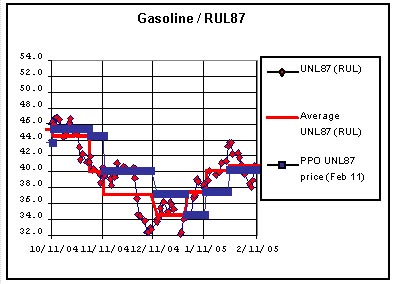
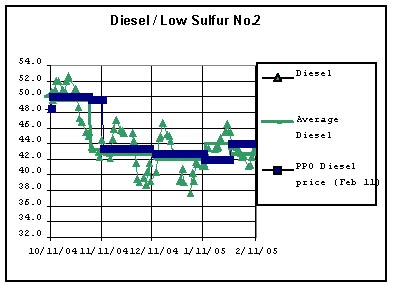
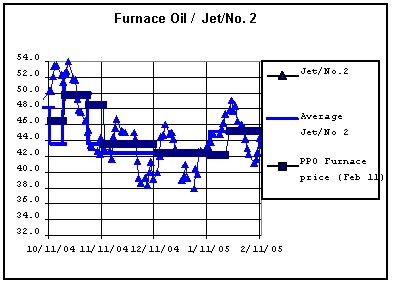
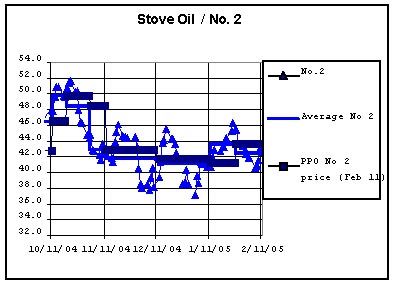
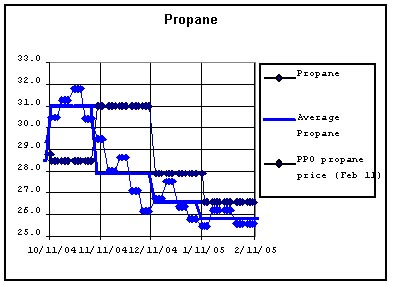
Media contact: Michelle Hicks, Communications. Tel: 1-866-489-8800
or (709) 489-8837.
1. Automotive Fuels - Maximum Retail Pump Prices - Effective
February 15, 2005;
2. Heating Fuels - Maximum Tank Wagon (or ** Tank Farm) Prices -
February 15, 2005;
3. Heating Fuels - Residential Propane - Maximum Tank Wagon Prices -
Effective February 15, 2005.
2005 02 15
10:00 a.m. |









